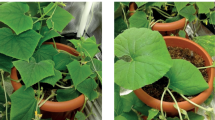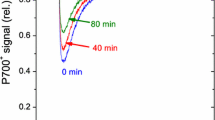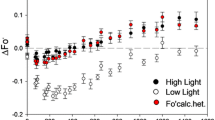Abstract
The effect of elevated temperature on electron flow to plastoquinone pool and to PSI from sources alternative to PSII was studied in barley (Hordeum vulgare L.) and maize (Zea mays L.) leaves. Alternative electron flow was characterized by measuring variable fluorescence of chlorophyll and absorption changes at 830 nm that reflect redox changes of P700, the primary electron donor of PSI. The treatment of leaves with elevated temperature resulted in a transient increase in variable fluorescence after cessation of actinic light. This increase was absent in leaves treated with methyl viologen (MV). The kinetics of P700+ reduction in barley and maize leaves treated with DCMU and MV exhibited two exponential components. The rate of both components markedly increased with temperature of the heat pretreatment of leaves when the reduction of P700+ was measured after short (1 s) illumination of leaves. The acceleration of both kinetic components of P700+ reduction by high-temperature treatment was much less pronounced when P700+ reduction rate was measured after illumination of leaves for 1 min. Since the treatment of leaves with DCMU and MV inhibited both the electron flow to PSI from PSII and ferredoxin-dependent cycling of electrons around PSI, the accelerated reduction of P700+ indicated that high temperature treatment activated electron flow to PSII from reductants localized in the chloroplast stroma. We conclude that the lesser extent of activation of this process by elevated temperature after prolonged illumination of heat-inhibited leaves is caused by depletion of the pool stromal reductants in light due to photoinduced electron transfer from these reductants to oxygen.
Similar content being viewed by others
REFERENCES
Stitt, M., Limitation of Photosynthesis by Carbon Metabolism: 1. Evidence for Excess Electron Transport Capacity in Leaves Carrying out Photosynthesis in Saturating Light and CO2, Plant Physiol., 1986, vol. 81, pp. 1115–1122.
Baker, N.R., A Possible Role for Photosystem II in Environmental Perturbations of Photosynthesis, Physiol. Plant., 1991, vol. 81, pp. 563–570.
Bukhov, N.G. and Mohanty, P., Elevated Temperature Stress Effects on Photosystems: Characterization and Evaluation of the Nature of Heat Induced Impairments, Concepts in Photobiology, Photosynthesis and Photomorphogenesis, Singhal, G.S. et al., Eds., New Delhi: Narosa Publ. House, 1999, pp. 617–648.
Krause, G.H. and Behrend, U., ?pH-Dependent Chlorophyll Fluorescence Quenching Indicating a Mechanism of Protection against Photoinhibition of Chloroplasts, FEBS Lett., 1986, vol. 200, pp. 298–302.
Poulson, M., Samson, G., and Whitmarsh, J., Evidence that Cytochrome b-559 Protects Photosystem II against Photoinhibition, Biochemistry, 1995, vol. 34, pp. 10932–10938.
Cleland, R.E. and Bendall, D.S., Photosystem I Cyclic Electron Transport: Measurement of Ferredoxin-Plastoquinone Reductase Activity, Photosynth. Res., 1992, vol. 34, pp. 409–418.
Arnon, D.I. and Chain, R., Regulation of Ferredoxin-Catalyzed Photosynthetic Photophosphorylations, Proc. Natl. Acad. Sci. USA, 1975, vol. 72, pp. 4961–4965.
Badger, M.R., Photosynthetic Oxygen Exchange, Annu. Rev. Plant Physiol., 1985, vol. 36, pp. 27–53.
Albertsson, P.-Å., The Structure and Function of the Chloroplast Photosynthetic Membrane-a Model for the Domain Organization, Photosynth. Res., 1995, vol. 46, pp. 141–149.
Feild, T.S., Nedbal, L., and Ort, D.R., Non-Photochemical Reduction of the Plastoquinone Pool in Sunflower Leaves Originated from Chlororespiration, Plant Physiol., 1998, vol. 116, pp. 1209–1218.
Funk, E., Schafer, E., and Steinmuller, K., Characterization of the Complex I-Homologous NAD(P)H-Plaslastoquinone-Oxidoreductase (NDH-Complex) of Maize Chloroplasts, J. Plant Physiol., 1999, vol. 154, pp. 16–23.
Groom, Q., Kramer, D.M., Crofts, A.R., and Ort, D.R., The Non-Photochemical Reduction of Plastoquinone in Leaves, Photosynth. Res., 1993, vol. 36, pp. 205–215.
Havaux, M., Short-Term Responses of Photosystem II to Heat Stress. Induction of a PS II-Independent Electron Transport through PS I Fed by Stromal Components, Photosynth. Res., 1996, vol. 47, pp. 85–97.
Bukhov, N.G., Wiese, C., Neimanis, S., and Heber, U., Heat Sensitivity of Chloroplasts and Leaves: Leakage of Protons from Thylakoids and Reversible Activation of Cyclic Electron Transport, Photosynth. Res., 1999, vol. 59, pp. 81–93.
Egorova, E.A. and Bukhov, N.G., Effect of Elevared Temperatures on the Activities of Alternative Pathways of Photosynthetic Electron Transport in Intact Barley and Maize, Fiziol. Rast. (Moscow), 2002, vol. 49, pp. 645–655 (Russ. J. Plant Physiol., Engl. Transl.).
Fujii, T., Yokoyama, E., Inoue, K., and Sakurai, H., The Sites of Electron Donation of Photosystem I to Methyl Viologen, Biochim. Biophys. Acta, 1990, vol. 1015, pp. 41–48.
Schreiber, U., Schliwa, U., and Bilger, W., Continuous Recording of Photochemical and Non-Photochemical Chlorophyll Fluorescence Quenching with a New Type of Modulation Fluorometer, Photosynth. Res., 1986, vol. 10, pp. 51–62.
Schreiber, U., Klughammer, C., and Neubauer, C., Measuring P700 Absorbance Changes around 830 nm with a New Type of Pulse Modulated System, Z. Naturforsch., 1988, vol. 43c, pp. 686–698.
Diner, B.A., Dependence of the Deactivation Reactions of Photosystem II on the Redox State of Plastoquinone Pool A Varied under Anaerobic Conditions. Equilibria on the Acceptor Side of Photosystem II, Biochim. Biophys. Acta, 1977, vol. 460, pp. 247–258.
Egorova, E.A., Bukhov, N.G., Krendeleva, T.E., and Rubin, A.B., Heterogeneity of Quinone Acceptor Reduction in Intact Barley Leaves, Dokl. Akad. Nauk, 2001, vol. 377, pp. 1–4.
Bennoun, P., Réoxidation du quencher de fluorescence “Q” en présence de 3-(3,4-Dichlorophényl)-1,1-Diméthylurea, Biochim. Biophys. Acta, 1970, vol. 216, pp. 357–363.
Bukhov, N.G., Samsom, G., and Carpentier, R., Non-Photosynthetic Reduction of the Intersystem Electron Transport Chain of Chloroplasts Following Heat Stress: The Pool Size of Stromal Reductants, Photochem. Photobiol., 2001, vol. 74, pp. 438–443.
Sazanov, L., Burrows, P., and Nixon, P., The Chloroplast NDH Complex Mediates the Dark Reduction of the Plastoquinone Pool in Response to Heat Stress in Tobacco Leaves, FEBS Lett., 1998, vol. 429, pp. 115–118.
Author information
Authors and Affiliations
Rights and permissions
About this article
Cite this article
Egorova, E.A., Bukhov, N.G., Heber, U. et al. Effect of the Pool Size of Stromal Reductants on the Alternative Pathway of Electron Transfer to Photosystem I in Chloroplasts of Intact Leaves. Russian Journal of Plant Physiology 50, 431–440 (2003). https://doi.org/10.1023/A:1024700202498
Issue Date:
DOI: https://doi.org/10.1023/A:1024700202498




